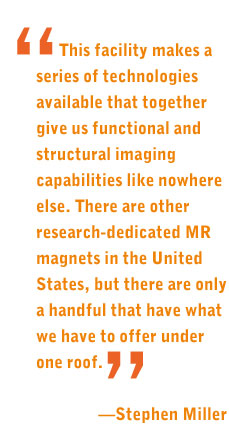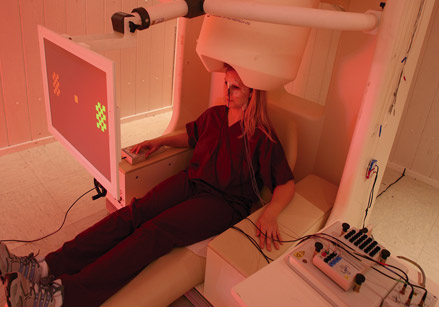


Big BIRC On Campus
by Rebecca Ayer
Intro
|
Improving Prospects
|
Not Only the Brain
|
Advancing the State of the Art

![]()
“Cat Scan” Reveals Brain Tumors
Training a New Generation of Scientists

Improving Prospects For Recovery
In their own research, Clementz and McDowell use these neuroimaging techniques to map the brain’s neural circuitry in hopes of determining the causes of normal and abnormal aging, and schizophrenia, a debilitating disease that affects nearly 1 in 100 people.
Individuals with schizophrenia suffer from terrifying symptoms—distorted perceptions of reality, hallucinations, delusions, and disordered thinking. To better understand the nature of this information breakdown in the schizophrenic brain, Clementz uses MEG and EEG to compare brain-activity data from healthy and mentally ill individuals.

Magnetoencephalography (MEG) works by detecting the magnetic fields created by the brain's electric signals. These fields are a billion times smaller than the Earth's magnetic field, so MEG has to be carried out in a heavily shielded room.
McDowell incorporates fMRI techniques, along with MEG and EEG, in her investigations of how the brain changes as a person practices a task and gets better at it.
“We have an interest in this because we wonder if we can do things to make the prefrontal cortex—the specific region of the brain known to be impaired in schizophrenia—look more normal in people who have schizophrenia,” said McDowell. “What we find may have a host of implications for functional rehabilitation.”
Intro
|
Improving Prospects
|
Not Only the Brain
|
Advancing the State of the Art
For comments or for information please e-mail: rcomm@uga.edu
To contact the webmaster please email: ovprweb@uga.edu
![]()